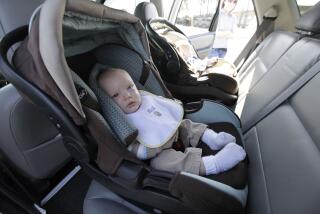Child Car Restraints Are Often Left Off or Misused, Experts Say
- Share via
Despite laws in all 50 states that require the use of child restraints in moving vehicles, car crashes are the leading cause of preventable death during childhood. Every year, about 2,000 boys and girls between infancy and age 15 die in vehicular crashes, and an additional 300,000 are injured.
Many of these deaths and injuries occur because child restraints are used improperly or not at all. The national Centers for Disease Control and Prevention estimates that restraints are not used at all for 16% of children under the age of 5, 43% of children between 5 and 11 and 71% of children 12 to 18. Even when they are used, studies show, 80% of the time they are used incorrectly.
Properly used safety restraints can significantly reduce your child’s risk of serious injury or death during a car crash. Here are some guidelines to follow:
* Place all infants and children under 12 in restraints in the back seat. Children seated in back are less likely to be seriously injured or die in a crash than children in the front seat.
* Put infants in rear-facing car seats until they are at least 1 year old and weigh 20 pounds. Because their heads are disproportionately large and their neck muscles are weak, infants in the forward-facing position have a higher risk of spinal injuries in the neck during crashes. Infants who weigh 20 pounds before 1 year of age should use a rear-facing car seat approved for higher weights until their first birthday.
* Never place a rear-facing car seat in the front seat of any vehicle equipped with a passenger-side air bag. The air bag inflates so quickly, it can strike a rear-facing seat with enough force to kill a child.
* Test the car seat before each use to be sure it is securely in place. Pull it firmly forward, and push it from side to side. If it moves more than 1 inch in any direction, it must be secured more snugly. Do this by placing your knee in the seat and pushing it into the seat of the car as you tighten the belt down.
In a properly adjusted rear-facing car seat, the shoulder straps should exit a slot of the seat at or below the level of your baby’s shoulders. In a forward-facing seat, the straps should exit above the level of the shoulders. Chest clips should be placed at armpit level to keep shoulder straps in the proper position. Straps must be snug (you should be able to slip only one finger underneath the straps at your child’s chest).
* Cover your infant with blankets after the child is secured in the car seat. The harness cannot be properly fitted over a child who is swaddled in blankets beforehand.
* Complete and mail the registration card that comes with your car seat. This enables the manufacturer to contact you promptly in the event of a safety recall. You can check to see if an older car seat has been recalled by calling the U.S. Department of Transportation’s Auto Safety Hotline at (888) DASH-2-DOT.
* If your child is more than 40 pounds but not yet ready for a regular safety belt, use a booster seat. It lifts the child into a position that makes the car’s seat belt safe and effective. According to the Department of Transportation, booster seats are a safer choice than belt-cinching devices marketed as booster-seat substitutes.
How do you know when your child is ready for a regular car safety belt? Your child should be able to sit upright comfortably against the seat back, with knees bent over the edge of the seat and feet on the floor. A properly fitted shoulder belt should lie across your child’s chest and shoulder (not the neck); the lap belt should lie low and flat across the hips (not the stomach). Most children are not ready for regular safety belts until about age 9.
* Never allow a child to tuck the shoulder belt under an arm or behind the back. Without the support of the shoulder strap, a child’s upper body can be thrown forward during a crash, which increases the risk of abdominal and spinal cord injuries. For this reason, lap-only belts should be avoided.
* If an older child must ride in the front passenger seat, move the seat back as far as it will go. This will minimize the risk of injury if the passenger-side air bag is deployed.
* Restrain your child every time you get in the car, even on short trips. Most accidents occur close to home, since that is where most of your driving is done.
* Set a good example and buckle up yourself every time.
* For more information about child restraints: National Highway Traffic Safety Administration, 400 7th St. SW, Washington, DC 20590. Internet: https://www.nhtsa.dot.gov.
*
Dr. Jonathan Fielding is the director of public health and health officer for the Los Angeles County Department of Health Services. Valerie Ulene is a board-certified specialist in preventive medicine practicing in Los Angeles. Then can be reached by e-mail at yourhealth@dhs.co.la.ca.us
More to Read
Sign up for Essential California
The most important California stories and recommendations in your inbox every morning.
You may occasionally receive promotional content from the Los Angeles Times.













